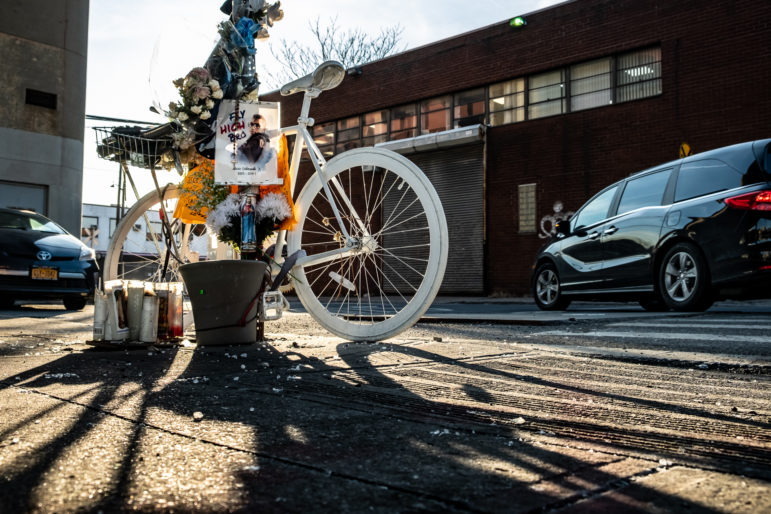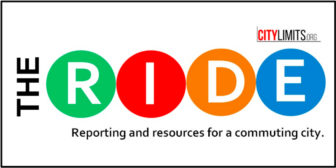
Adi Talwar
On September 21, 2019, while riding his bicycle, Astoria resident Mario Valenzuela (14) was killed in a crash with a private sanitation truck at around 2:00 p.m. near a railroad crossing on 11th Street close to Borden Avenue in Long Island City, Queens.
In July, Hundreds of bike riders and advocates gathered in Washington Square Park for a “die in” protest, laying their bicycles and bodies on the ground and calling for the city to respond to a crisis in the community: 15 cyclists who’d been killed in 2019 so far. The demonstrators held signs bearing crash victims’ names, and in speeches, demanded an end to the carnage.
But in the five months since that protest, the city’s cyclist death toll has continued to rise. As of mid-December, NYPD data lists 27 cyclists who’ve been struck and killed by vehicles this year, though advocacy groups put the count at 28. That’s up from a record-low of 10 cyclist fatalities in 2018, and experts say it’s hard to pinpoint a direct or single cause behind the increase. They instead point to a confluence of factors, including an increasing population, more cars and larger vehicles on city streets, and insufficient bike infrastructure that hasn’t kept up with the growing popularity of cycling.
[It’s] a number of trends coming to a head on our streets,” says Mike Lydon, principal at urban planning research firm Street Plans. “The pressure on the city to reduce driving, I think, is one of the core issues here.”
The increase is in line with other city and national trends: While New York’s overall traffic deaths hit a record low in 2018, pedestrian deaths rose from the year before, to 115 fatalities (in 2019 so far, there have been 112 crashes where pedestrians were killed, NYPD data shows). Nationwide, 857 cyclists were killed in traffic last year, up 22 percent from 2017, according to the National Transportation Safety Board.
Cycling advocates see promise in recent city initiatives—like Mayor Bill de Blasio’s $58.4 million “Green Wave” plan, which pledged to build 30 miles of protected bike lanes a year—but say they’d like to see the administration take more aggressive action overall when it comes to transforming New York’s streets.
“We need to elevate this notion of spatial inequity,” says Danny Harris, executive director for transit advocacy group Transportation Alternatives. “If you look at garbage on the sidewalks, double and triple-parked cars, freight that’s taking over our cities … our whole system is broken.”
More cars, busier streets
Over the last several years, activity on the city’s roadways has surged: The rise of ride-share apps like Uber and Lyft contributed to a massive increase in the number of For Hire Vehicle (FHV) trips, which rose by nearly 90 percent since 2010. Car ownership is also up, while the growing popularity of Amazon Prime and other at-home delivery services means more truck and van trips delivering goods across the boroughs.
“More driving, more cars, more car ownership, more Uber, Lyft, and especially more trucks—more trucks delivering,” says Jon Orcutt, communications director for Bike New York. “More of everything has kind of caught up with the city’s safety measures.”
Though the number of New Yorkers who ride a bike regularly dipped this year and last, cycling in the city overall has grown significantly over the last several years, with total daily bike trips up a whopping 133 percent between 2007 and 2017, aided by the popularity of the Citi Bike program.
“In the broad sense, it’s the high number of bike riders colliding with the increase in traffic, and I think to some degree the frustration of drivers in traffic,” says Orcutt, of Bike New York.
Others also point to there being more trucks and larger vehicles, like SUVs, on city streets—something Transportation Commissioner Polly Trottenberg blamed for the uptick in cyclist deaths, as a number of this year’s fatal cyclist crashes involved trucks.
“There continues to be an appetite among the American populace and the automakers in producing bigger and more lethal cars,” says Harris, who also pointed to the common sight of drivers using their smartphones behind the wheel. “We created this almost perfect storm of giving people almost infinite distraction, and giving them more and more lethal vehicles.”
All bike lanes are not created equal
De Blasio responded to the cycling deaths in July with the launch of his “Green Wave” plan, pledging to build more protected bike lanes and install other traffic-calming measures, increase police enforcement against dangerous drivers and do more public outreach around bike safety. Earlier this month, the city also rolled out a pilot program that will use cargo bikes to deliver packages in Manhattan, an effort to reduce truck usage. Congestion pricing is slated to go into effect 2021, attempting to relieve car traffic at least in Manhattan’s business district.
Advocates say they’re cheered by such initiatives, but think their success will come down to implementation, and some question the mayor’s commitment to the goals he’s set. In 2018, de Blasio angered cyclists when he told WNYC’s Brian Lehrer he didn’t think a driver should get ticketed for blocking the “bike lane for 30 seconds while they take out the groceries or let their kid off.”
Indeed, Orcutt points to projects like the Grand Street bike lane in Williamsburg as an example of a “crappy lane.” Despite its designation by the city as a protected bike lane—meaning there’s a buffer space between the cycling lane and street traffic—Grand Street has no meaningful physical barrier protecting bike riders besides occasional plastic delineators, what Orcutt calls merely “skinny plastic sticks.”
“They’re placed so far apart that you can just drive between them. It’s a disaster,” he says, adding that the bike lane is so “filled with cars and trucks all the time,” that it’s been rendered largely useless.
“New York City would never build half of a bridge, but they’re doing just that with their bike network,” says Harris, of Transportation Alternatives.
Orcutt says the most successful bike lanes offer real protection without being “impermeable.” He points to the 8th Avenue bike lane outside Manhattan’s Port Authority as a good example, as it uses closely-spaced, larger plastic bollards to create a “pretty robust barrier” between bikes and cars.
Bolder steps needed
In addition to the mayor’s bike plan, the City Council this year passed Speaker Corey Johnson’s “streets master plan” legislation, which requires the city’s Department of Transportation to produce a plan for the city’s streets every five years, with the goal of improving pedestrian and cyclist safety, and cut down on car use. Experts praised the plan for taking a more ambitious approach to street safety, though it won’t be implemented until 2021.
“We obviously wish it were being started sooner,” says Harris. “The devil is in the details.”
Overall, advocates say they’d like the city to pursue more dramatic projects to transform city streets—carving out more space for pedestrians and cyclists—and to implement them more quickly. Currently, the DOT tends to take the lead on projects that are fairly quick fixes, such painting a new bike lane, crosswalk or installing plastic street dividers. But larger, more extensive capital construction projects are usually handled by the city’s Department of Design and Construction, and tend to take much longer; an NYU Rudin Center report from 2017 called the city’s capital construction process “maddeningly time-consuming and unnecessarily expensive.”
“DOT works with mostly plastic and paint, and the heavy construction is supposed to be done by DDC, and their projects take lifetimes,” says Orcutt.
“Our peers are killing us. If you look at Paris—they don’t do paint. They go straight to capital projects,” he adds. “How do we create a nimble capital program than can give us street projects quicker?”
Lydon, of Streets Plans, thinks transit construction projects might be better carried out if they were handled by one agency instead of several. He and others argue that the city should be pursuing more pedestrian and cyclist-friendly street redesigns, pointing to recent initiatives like the 14th Street busway and creating car-free spaces around Rockefeller Center this holiday season as examples of what they’d like to see more of.
“The nice thing to focus on about 14th Street is how residents are starting to see what they could imagine in New York on their street. What could we be doing with this space now?” says Harris. “We’ve never really given New Yorkers that opportunity to see their street differently.”









